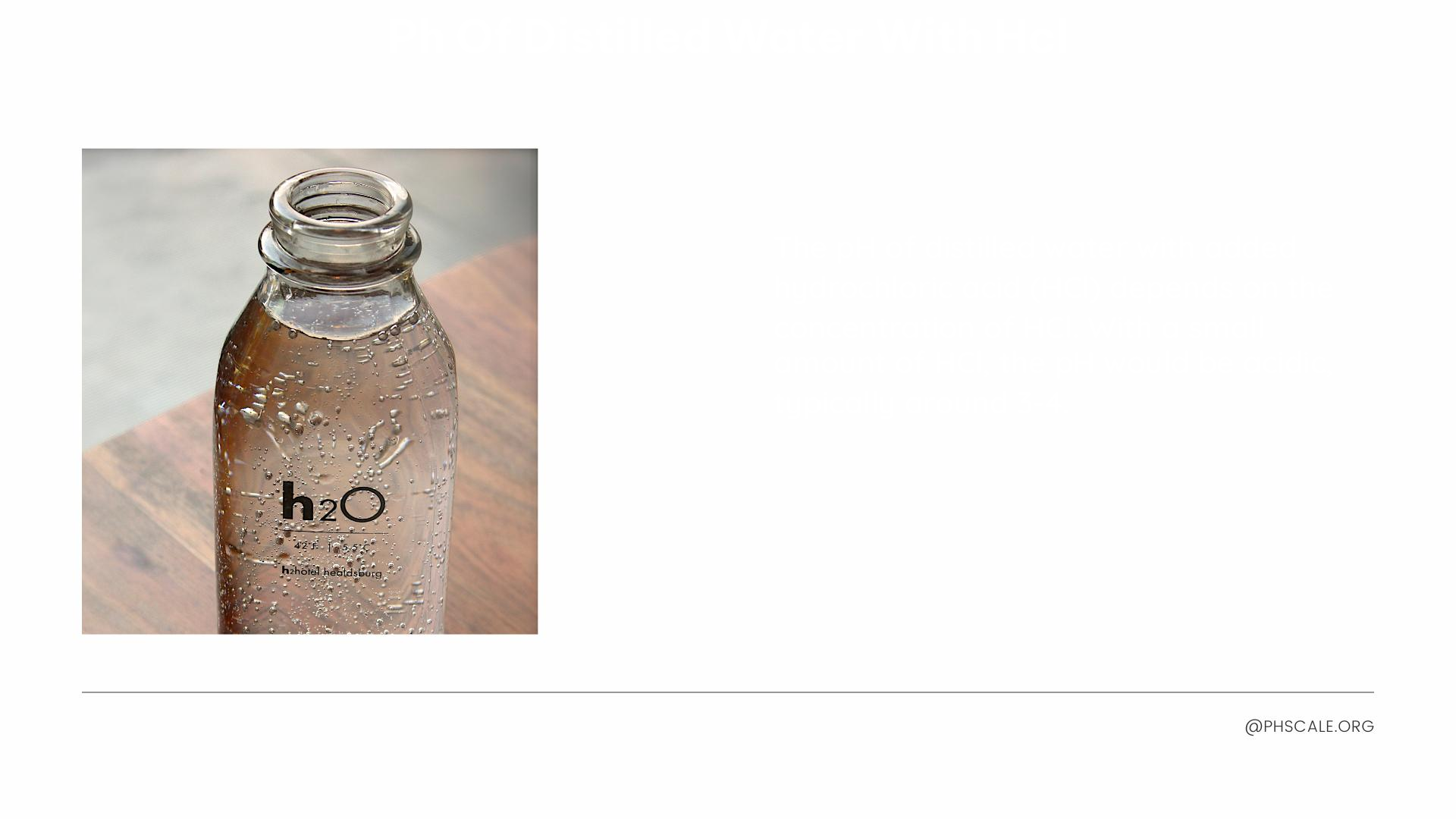The pH of distilled water can vary depending on several factors, including the level of purity and exposure to air. Pure distilled water generally has a pH of 7, which is neutral on the pH scale. However, distilled water is rarely 100% pure and can have a pH slightly below 7 due to the presence of impurities or the absorption of carbon dioxide from the air, which forms carbonic acid and releases hydronium ions, making the solution slightly acidic.
Understanding the pH of Distilled Water
Distilled water is a highly purified form of water that has been stripped of most impurities through the process of distillation. This process involves boiling water and then condensing the steam to produce a pure, mineral-free liquid. The resulting distilled water is considered one of the purest forms of water available.
The pH of distilled water is primarily determined by the presence of hydrogen ions (H+) in the solution. In pure distilled water, the concentration of H+ and hydroxide ions (OH-) is equal, resulting in a neutral pH of 7. However, distilled water can easily absorb carbon dioxide (CO2) from the air, which can lower the pH and make the solution slightly acidic.
When CO2 dissolves in water, it forms carbonic acid (H2CO3), which then dissociates into bicarbonate (HCO3-) and hydrogen ions (H+). This process can lower the pH of distilled water to around 5.6, making it slightly acidic.
Adding Hydrochloric Acid (HCl) to Distilled Water

When hydrochloric acid (HCl) is added to distilled water, the pH of the solution changes significantly. HCl is a strong acid that completely dissociates in water, releasing hydrogen ions (H+) and lowering the pH of the solution.
The extent of the pH change depends on the concentration of HCl and the volume of distilled water. To calculate the pH of the resulting solution, you can use the following formula:
pH = -log[H+]
Where [H+] is the concentration of hydrogen ions in the solution.
Here are a few examples:
-
If 8 ml of 0.3 M HCl solution is mixed with 12 ml of distilled water, the pH of the diluted solution can be calculated as follows:
-
Initial [H+] = 0.3 M
- Final [H+] = (8 ml × 0.3 M) / (8 ml + 12 ml) = 0.12 M
-
pH = -log[0.12] = 0.92
-
If 1 ml of 0.01 mol HCl solution is added to 1 liter of distilled water initially at pH 7, the pH of the solution will decrease to approximately 2.0.
-
Initial [H+] = 10^-7 M (pH 7)
- Final [H+] = (1 ml × 0.01 mol) / (1000 ml) = 1 × 10^-5 M
- pH = -log[1 × 10^-5] = 5
To achieve a specific pH, such as pH 2, using 37% HCl, the concentration of HCl needs to be calculated and then diluted accordingly. For instance, to make 250 ml of solution with a pH of 2, about 0.21 ml of 37% HCl needs to be added to the distilled water.
Factors Affecting the pH of Distilled Water with HCl
The pH of distilled water with HCl is influenced by several factors:
- Concentration of HCl: The higher the concentration of HCl, the more hydrogen ions (H+) will be released, resulting in a lower pH.
- Volume of Distilled Water: The volume of distilled water used will dilute the HCl, affecting the final pH.
- Purity of Distilled Water: The presence of impurities in the distilled water can also influence the pH, as they may react with the HCl or the hydrogen ions.
- Temperature: The temperature of the solution can affect the dissociation of HCl and the solubility of CO2, which can impact the pH.
Applications of Distilled Water with HCl
The combination of distilled water and HCl has various applications in different fields, including:
- Laboratory and Research: Distilled water with HCl is commonly used in laboratory settings for pH adjustments, titrations, and other analytical procedures.
- Industrial Processes: In some industrial processes, such as metal cleaning or etching, distilled water with HCl is used to create specific pH conditions.
- Pharmaceutical and Medical: Distilled water with HCl may be used in the preparation of certain pharmaceutical formulations or as a component in medical treatments.
- Environmental Studies: Distilled water with HCl can be used in environmental research, such as studying the effects of acid rain or the pH of water bodies.
Conclusion
The pH of distilled water can vary depending on the level of purity and exposure to air, but it is generally neutral (pH 7). When hydrochloric acid (HCl) is added to distilled water, the pH of the solution decreases significantly, making it acidic. The extent of the pH change depends on the concentration of HCl and the volume of distilled water. Understanding the pH of distilled water with HCl is crucial in various applications, from laboratory research to industrial processes and environmental studies.
Reference:
1. pH of Distilled Water
2. Calculating pH of HCl Solutions
3. Diluting Concentrated HCl
